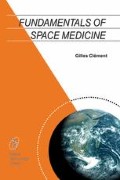Access this chapter
Tax calculation will be finalised at checkout
Purchases are for personal use only
Preview
Unable to display preview. Download preview PDF.
6 References
Bloomberg JJ, Peters BT, Smith S.L, Huebner WP, Reschke MF (1997) Locomotor head-trunk coordination strategies following spaceflight. Journal of Vestibular Research 7: 161–177
Bloomberg JJ et al. (1999) Effects of spaceflight on locomotor control. In Extended Duration Orbiter Medical Project. Final Report 1989–1995. Sawin CF, Taylor GR (eds) Houston, TX: NASA SP-1999-534, Chapter 5.5
Clément G (1998) Alteration of eye movements and motion perception in microgravity. Brain Research Reviews 28: 161–172
Clément G, Lestienne F (1988) Adaptive modifications of postural attitude in conditions of weightlessness. Experimental Brain Research 72: 381–389
Clément G, Reschke MF (1996) Neurosensory and sensory-motor functions. In: Biological and Medical Research in Space: An Overview of Life Sciences Research in Microgravity. Moore D, Bie P, Oser H (eds), Heidelberg: Springer-Verlag, Chapter 4, pp 178–258
Clément G, Moore S, Raphan T, Cohen B (2001) Perception of tilt (somatogravic illusion) in response to sustained linear acceleration during spaceflight. Experimental Brain Research 138: 410–418
Clément G et al. (2003) Perception of the Spatial Vertical during Centrifugation and Static Tilt. In: The Neurolab Mission: Neuroscience Research in Space. Buckey JC, Homick JL (eds) Johnson Space Center, Houston TX: U.S. Government Printing Office, NASA SP-2003-535, pp 5–10
Crampton GH (ed) Motion and Space Sickness. Boca Raton: CRC Press, 1990
Davis JR, Vanderploeg JM, Santy PA, Jennings RT, Stewart DF (1988) Space motion sickness during 24 flights of the Space Shuttle. Aviation Space Environmental Medicine 59: 1185–1189
Godwin R (1999) Apollo 12 NASA Mission Reports. Burlington, Canada: Apogee Books, CG Publishing Inc.
Gorgiladze GI, Bryanov II (1989) Space motion sickness. Space Biology and Aerospatial Medicine (in Russian) 23: 4–14
Gurfinkel VS, Lestienne F, Levik YS, Popov KE, Lefort L (1993) Egocentric references and human spatial orientation in microgravity. II. Body-centered coordinates in the task of drawing ellipses with prescribed orientation. Experimental Brain Research 95: 343–348
Homick JL, Miller EF II (1975) Apollo flight crew vestibular assessment. In: Biomedical Results of Apollo. Johnston RS, Dietlein LF, Berry CA (eds) Washington DC: U.S. Government Printing Office, NASA SP-368, pp 323–340
Jones JA (1997) Angular momentum conservation: Astronauts at play. The College of Wooster, Junior Thesis, Physics Department. Available at: http://www.wooster.edu/physics/JrIS/Files
Lackner J, DiZio P (2000) Human orientation and movement control in weightless and artificial gravity environments. Experimental Brain Research 130: 2–6
Lathan C, Wang Z, Clément G (2000) Changes in the vertical size of a three-dimensional object drawn in weightlessness by astronauts. Neuroscience Letters 295: 37–40
Léone G (1998) The effect of gravity on human recognition of disoriented objects. Brain Research Reviews 28: 203–214
McIntyre J, Zago M, Berthoz A, Lacquaniti F (2001) Does the brain model Newton’s laws? Nature Neuroscience 4: 693–694
Mittelstaedt H, Glasauer S (1993) Crucial effects of weightlessness on human orientation. Journal of Vestibular Research 3: 307–314
Money KE (1990) Motion sickness and evolution. In: Crampton G (ed) Motion and Space Sickness. Boca Raton, FL: CRC Press
Oman CM, Lichtenberg BK, Money KE (1990) Space motion sickness monitoring experiment: Spacelab 1. In: Motion and Space Sickness. Crampton GH (ed) Boca Raton, FL: CRC Press, pp 217–246
Paloski WH, Black FO, Reschke MF, Calkins DS, Shupert C (1993) Vestibular ataxia following shuttle flights: effects of microgravity on otolith-mediated sensorimotor control of posture. American Journal of Otology 14: 9–17
Parker DE, Reschke MF, Arrott AP, Homick JL, Lichtenberg BK (1985) Otolith tilt-translation reinterpretation following prolonged weightlessness: implications for pre-flight training. Aviation Space Environmental Medicine 56: 601–606
Pettit D (2003) Expedition Six Space Chronicles. Available at http://spaceflight.nasa.gov/station/crew/exp6/spacechronicles.html
Pozzo T, Berthoz A, Lefort L (1990) Head stabilization during various locomotor tasks in humans. 1. Normal subjects. Experimental Brain Research 82: 97–106
Ross HE, Brodie EE, Benson AJ (1986) Mass-discrimination in weightlessness and readaptation to earth’s gravity. Experimental Brain Research 64: 358–366
Ross MD, Tomko DL (1998) Effects of gravity on vestibular neural development. Brain Research Reviews 28: 44–51
Thornton WE, Biggers WP, Thomas WG, Pool SL, Thagard NE (1985) Electronystagmography and audio potentials in spaceflight. Laryngoscope 95: 924–932
Watt DGD (1997) Pointing at memorized targets during prolonged microgravity. Aviation, Space and Environmental Medicine 68: 99–103
Watt DGD (2001) Background Material On H-REFLEX Experiment. Available at: http:/space.gc.ca/asc/eng/csa_sectors/space_science/life_sciences/h-reflex.asp
Young LR, Oman CM, Watt DGD, Money KE, Lichtenberg BK, Kenyon RV, Arrott AP (1986) MIT/Canadian vestibular experiments on the Spacelab-1 mission: 1. Sensory adaptation to weightlessness and readaptation to one-g: an overview. Experimental Brain Research 64: 291–298
Additional Documentation
Clément G, Droulez J (1983) Microgravity as an Additional Tool for Research in Human Physiology with Emphasis on Sensori-Motor Systems. Noordwijk, NL: European Space Agency Publication Division, ESA BR-15
Clément G (2001) The human sensory and balance system. In: A World Without Gravity. Fitton B, Battrick B (eds) Noordwijk, NL: European Space Agency Publication Division, ESA SP-1251, pp 93–111
Crampton G (ed) (1990) Motion and Space Sickness. Boca Raton, FL: CRC Press
International Workshop on Human Factors in Space (2000) Aviation Space Environmental Medicine 71, No. 9, Section II, Supplement
Man-Systems Integration Standards (1995) Revision B, Volume 1, NASASTD-3000. Houston, TX: National Aeronautics and Space Administration
Space Neuroscience Research (1998) Brain Research Reviews, Volume 28, Numbers 1 and 2, Special Issue
The Neurolab Mission: Neuroscience Research in Space (2003) Buckey JC, Homick JL (eds) Johnson Space Center, Houston TX: U.S. Government Printing Office, NASA SP-2003-535
Rights and permissions
Copyright information
© 2005 Springer
About this chapter
Cite this chapter
(2005). The Neuro-Sensory System in Space. In: Fundamentals of Space Medicine. The Space Technology Library, vol 17. Springer, Dordrecht. https://doi.org/10.1007/1-4020-3434-2_3
Download citation
DOI: https://doi.org/10.1007/1-4020-3434-2_3
Publisher Name: Springer, Dordrecht
Print ISBN: 978-1-4020-3246-2
Online ISBN: 978-1-4020-3434-3
eBook Packages: EngineeringEngineering (R0)

